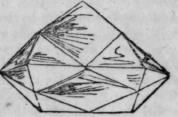Diamons
Description
This section is from the book "The Corner Cupboard; Or, Facts For Everybody", by Robert Kemp Philp. Also available from Amazon: The Corner Cupboard; or Facts for Everybody.
Diamons
Diamons. The diamond is found mostly in the East Indies and South America. Its chief feature consists in its excessive hardness, which far exceeds all other bodies, and by which, and its colour and briiliancy, it may be easily known from all other stones; for whilst it possesses the property of scratching or cutting all known substances, there has been none found capable of acting in a similar manner on it. It is rather more than three times and a half as heavy as water; it is neither volatile nor fusible, and will not dissolve in any liquid. It is generally devoid of colour ; but sometimes occurs tinted of a bluish, yellow, or rose colour - these colours add to its value according to the beauty of the tint. In its rough state, as when found, it is of a milky or brownish colour, and of an irregular rounded form, and sometimes crystallized. The diamond has been known from the earliest ages, and held in high estimation, not on account of its brilliancy (as the ancients were ignorant of the art of uttiug them, and wore them in the rough state), but because so few were found in nature. The art of cutting and polishing diamonds was not discovered until 1470. Up to this time no substance had been found that would grind them. But, by accident, two diamonds having been rubbed together, it was found that they polished each other - [this is the origin of the saying, " Diamond cut diamond"] - and upon this depends the whole art of cutting them. Two diamonds are secured in handles, and rubbed against each other to grind them to the shape required, and the dust that falls is used, mixed with oil, to polish them. The Romans used to pound small diamonds to powder, to cut and polish other stones ; but this does not seem to have suggested to them its use to polish itself. Diamonds are often called " rose diamonds," " table diamonds," and " brilliants ; " but this only refers to the manner in which they are cut, as there is but one kind of real diamond. When two diamonds are rubbed together, the point of contact forms a little flat surface ; this is called a "facet." Rose diamonds have all these facets tending to a point on the sides and top of the stone, as in Fig. 1, and the under side perfectly plain. Table-diamonds have a flat, oblong top, with the sides cut in very large facets, and the under side brought to a point, also, with large facets. The brilliant, which is the most valuable form, is somewhat of the same shape, but has the flat face on top very much smaller, and nearly round; and the sides and bottom are cut into a greater number of smaller facets, which, also, are made to reflect into each other - it thus emits the greatest light, and the most variegated colours; (see Fig 2 2.) The dust that comes from the cutting of diamonds is used for cutting cameos, crests, and letters on cornelians, and other stones, and for polishing the pebbles used for spectacles; without it they could not be worked.

Fig. 1.

Fig. 2.
The finest diamond ever known, except the gem recently brought to England, belonged to the king of Portugal; it weighed 1,680 carats, and was valued at .€224,000,000, though it was not cut or polished. That in the Russian sceptre weighs 779 carats, and is valued at .£4,000,000. The Pitt diamond weighed 136 carats, and cost Louis XIV. £130,000. These gems are brought from Borneo, Golconda, Bengal, the East Indies, West Indies, and Brazil. They are cut and polished with their own substance. The different kinds of diamonds are as follows : - Rough diamond is the stone as it comes from the mine; rose diamond is one which is flat at then base, terminating in a point above ; the table diamond has a square face at the top encompassed with four lesser facets ; the brilliant is that which is cut into flat faces at top and bottom, and whose table, or principal face, is parallel with a line through the broadest part of the stone. The diamonds used by glaziers are usually only fragments of badly-coloured stones.
Continue to:


